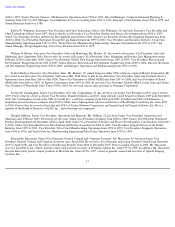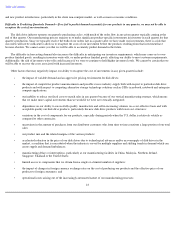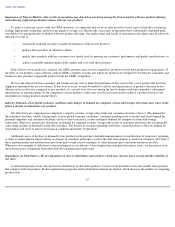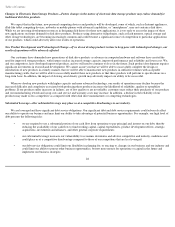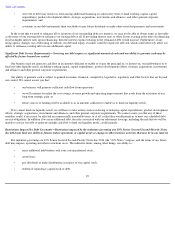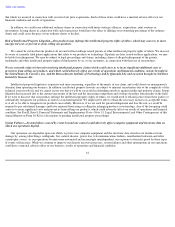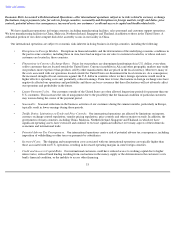Seagate 2009 Annual Report Download - page 25
Download and view the complete annual report
Please find page 25 of the 2009 Seagate annual report below. You can navigate through the pages in the report by either clicking on the pages listed below, or by using the keyword search tool below to find specific information within the annual report.
Table of Contents
and new product introductions, particularly in the client non-compute market, as well as macro-economic conditions.
Difficulty in Predicting Quarterly Demand
—If we fail to predict demand accurately for our products in any quarter, we may not be able to
recapture the cost of our investments.
The disk drive industry operates on quarterly purchasing cycles, with much of the order flow in any given quarter typically coming at the
end of that quarter. Our manufacturing process requires us to make significant product-specific investments in inventory in each quarter for that
quarter's production. Since we typically receive the bulk of our orders late in a quarter after we have made our investments, there is a risk that
our orders will not be sufficient to allow us to recapture the costs of our investment before the products resulting from that investment have
become obsolete. We cannot assure you that we will be able to accurately predict demand in the future.
The difficulty in forecasting demand also increases the difficulty in anticipating our inventory requirements, which may cause us to over-
produce finished goods, resulting in inventory write-offs, or under-produce finished goods, affecting our ability to meet customer requirements.
Additionally, the risk of inventory write-offs could increase if we were to continue to hold higher inventory levels. We cannot be certain that we
will be able to recover the costs associated with increased inventory.
Other factors that may negatively impact our ability to recapture the cost of investments in any given quarter include:
• the impact of variable demand and an aggressive pricing environment for disk drives;
•
the impact of competitive product announcements and possible excess industry supply both with respect to particular disk drive
products and with respect to competing alternative storage technology solutions such as SSDs in netbook, notebook and enterprise
compute applications;
•
our inability to reduce our fixed costs to match sales in any quarter because of our vertical manufacturing strategy, which means
that we make more capital investments than we would if we were not vertically integrated;
• dependence on our ability to successfully qualify, manufacture and sell in increasing volumes on a cost-effective basis and with
acceptable quality our disk drive products, particularly the new disk drive products with lower cost structures;
• variations in the cost of components for our products, especially during periods when the U.S. dollar is relatively volatile as
compared to other currencies;
•
uncertainty in the amount of purchases from our distributor customers who from time to time constitute a large portion of our total
sales;
• our product mix and the related margins of the various products;
•
accelerated reduction in the price of our disk drives due to technological advances and/or an oversupply of disk drives in the
market, a condition that is exacerbated when the industry is served by multiple suppliers and shifting trends in demand which can
create supply and demand imbalances;
•
manufacturing delays or interruptions, particularly at our manufacturing facilities in China, Malaysia, Northern Ireland,
Singapore, Thailand or the United States;
• limited access to components that we obtain from a single or a limited number of suppliers;
• the impact of changes in foreign currency exchange rates on the cost of producing our products and the effective price of our
products to foreign consumers; and
• operational issues arising out of the increasingly automated nature of our manufacturing processes.
23






